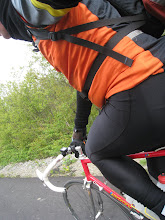The fruits of Quebec's deep-rooted bicycling culture
If you can believe that title, then the Canadian Press has a bicycle vacation for you!
Cycling enthusiasts saddle up to take in southern Quebec
Apr 4, 2008
MONTREAL — From craggy cliffs overlooking the St. Lawrence River to knobby cobblestones in Old Montreal, southern Quebec's geography and history can be seen from the saddle of a bike.
With more than 4,000 kilometres of bike trails, Quebec boasts the largest cycling network in the Americas, said Patrick Howe of Velo Quebec, a non-profit group that has promoted cycling in the province for 40 years.
"We now have a cycling identity, especially in Montreal," said Howe.
Travellers from around the continent are taking advantage of the fruits of Quebec's deep-rooted bicycling culture.
The Route verte - or Green Route - snakes along paved shoulders, quiet rural roads and old railway beds, cutting through more than 320 municipalities in Quebec.
Inaugurated last August, the Route verte was recently named the top cycling route in the world by the National Geographic Society.
With trails that lead bicyclists below shady forest canopies, along breezy coastal terrain and through the bustle of cities, its strength is diversity, said Howe.
"Each time I take my bike and head out on the Route verte I discover new corners of Quebec," he said.
Velo Quebec, which offers guided bike-touring packages around the province, will lead a troop of some 2,000 cyclists from across North America on its 15th annual Grand Tour in August.
The Grand Tour traces a new multi-day route each summer for bicycling enthusiasts of all skill levels.
Quebec's wealth of bike trails has also attracted interest from American tour operators.
Classic Adventures, based in Hamlin, N.Y., offers cycling travel packages to Greece, Austria and Germany, but Quebec has remained a top destination for about 20 years, said Mike Prohaska, a guide with the company.
"It gives them a taste of France without having to take a big plane ride," Prohaska said.
"We get that kind of old-world flavour in most places, a lot of French cuisine and excellent lodging."
He said the recreational tours, which serve cyclists of all ages from across the U.S. and Canada, stick mainly to low-traffic, secondary roads along the Route verte.
"They've been really popular over the years," he said. "We really love the cycling in Quebec."
Howe, meanwhile, said Montreal is no longer just a summer mecca for shoppers, foodies and festival-goers - it has become a cycling destination in its own right.
Once the snow melts - or even through the dead of winter for the zealous - the city becomes a hub of bicycle activity.
"It's huge," he said. "It's part of the image of Montreal."
Cyclists tackle Mont Royal for the sweeping views of the city's skyline and cruise the banks of the historic 14.5-kilometre Lachine Canal.
To celebrate their pedalling passion, Velo Quebec hosts the week-long Montreal Bike Fest, which kicks off May 25.
The festival includes an inter-city cycling competition, a nighttime ride through downtown Montreal and the annual Tour de l'Ile 50-kilometre race, where some 30,000 cyclists jockey for position on traffic-less streets.
Howe said the city plans to double Montreal's existing 350-kilometre biking network over the next seven years.
"Quebecers love to cycle and they demand more and more paths," he said. "And the more paths, the more Quebec cyclists we'll have."
If you go . . .
On the web: www.velo.qc.ca, for information on the Route verte, Montreal Bike Fest and the Grand Tour; www.pc.gc.ca/lhn-nhs/qc/canallachine/index-e.asp, Lachine Canal.


0 Comments:
Post a Comment
<< Home